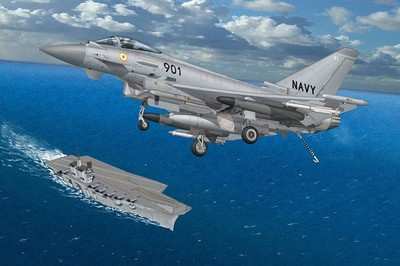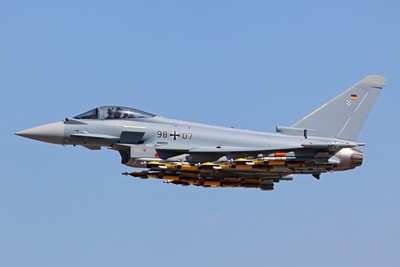Thu, Feb 24, 2011
Partner Companies Present Details At Aero India
More details about the studies conducted for the initial
definition of the "navalized" version of the Eurofighter Typhoon
were unveiled at Aero India 2011 this week.

Artist's Concept
These studies, conducted by Eurofighter and partner company BAE,
have included the assessment of required design changes, piloted
simulations to refine the aircraft's handling qualities and
discussions with key suppliers. The studies indicate that these
changes are feasible, and would lead to the development of a
world-beating, carrier-based fighter aircraft.
The most important element of the navalized Typhoon is that its
thrust-to-weight ratio allows the aircraft to take off from a
carrier without using a catapult but with a simple and much cheaper
"ski-jump". Detailed simulations have shown that the aircraft will
be able to take off and land in this way with a full weapon and
fuel load - providing a truly potent and flexible naval aviation
capability.

File Photo
The basic design of Typhoon helps to minimize the modifications
needed to allow a Typhoon to conduct naval operations from a
carrier. The aircraft's structure is exceptionally strong, having
been designed from the outset for the high dynamic loads associated
with extreme air combat maneuvering. The modifications required are
limited and include a new, stronger landing gear, a modified
arrestor hook and localized strengthening on some fuselage sections
near the landing gear, as well as updates the EJ200 engines.
To reduce the aircraft's approach speed and the resulting
landing loads the study envisages the introduction of a
thrust-vectored variant of the Eurojet EJ200 engine. Thrust
vectoring (Engines with TVN have already undergone factory testing
in the Eurojet facility) could be fully integrated into Typhoon's
advanced Flight Control System (FCS), allowing the pilot to focus
on flying the approach path while the FCS manages the engine nozzle
position. The ability to change the angle of the engines' thrust
will allow for a further enhancement in Typhoon's maneuverability,
supercruise performance, fuel consumption and the handling of
asymmetric weapon configurations.
Eurofighter says a key design driver for navalized Typhoon is
the commonality at 95 per cent with the land variant. Design
changes are minimized, allowing for most of the spare parts and
test equipment to be shared across a customer's air force and navy
fleets. The sensors, systems and weapons available to both variants
will be common, allowing for a reduction in the aircrew training
requirements. And in addition, the two variants will benefit from a
common upgrade path - new capabilities will be available to both
the air force and navy in similar timescales.
More News
Aero Linx: International Federation of Airworthiness (IFA) We aim to be the most internationally respected independent authority on the subject of Airworthiness. IFA uniquely combi>[...]
Ultrahigh Frequency (UHF) The frequency band between 300 and 3,000 MHz. The bank of radio frequencies used for military air/ground voice communications. In some instances this may >[...]
A Few Questions AND Answers To Help You Get MORE Out of ANN! 1) I forgot my password. How do I find it? 1) Easy... click here and give us your e-mail address--we'll send it to you >[...]
From 2019 (YouTube Edition): Learning To Paint Without Getting Any On Your Hands PPG's Aerospace Coatings Academy is a tool designed to teach everything one needs to know about all>[...]
Also: Sustainable Aircraft Test Put Aside, More Falcon 9 Ops, Wyoming ANG Rescue, Oreo Cookie Into Orbit Joby Aviation has reason to celebrate, recently completing its first full t>[...]
 ANN's Daily Aero-Linx (05.06.25)
ANN's Daily Aero-Linx (05.06.25) ANN's Daily Aero-Term (05.06.25): Ultrahigh Frequency (UHF)
ANN's Daily Aero-Term (05.06.25): Ultrahigh Frequency (UHF) ANN FAQ: Q&A 101
ANN FAQ: Q&A 101 Classic Aero-TV: Virtual Reality Painting--PPG Leverages Technology for Training
Classic Aero-TV: Virtual Reality Painting--PPG Leverages Technology for Training Airborne 05.02.25: Joby Crewed Milestone, Diamond Club, Canadian Pilot Insurance
Airborne 05.02.25: Joby Crewed Milestone, Diamond Club, Canadian Pilot Insurance




